Breakfast, dinner and supper in Georgian Dublin
Published in 18th-19th Century Social Perspectives, 18th–19th - Century History, Features, Issue 1 (Jan/Feb 2007), Volume 15
Mrs Mary Delany once wrote: ‘Got up at nine, and read a lecture to my family on the advantages of rising early! For want of the usual bell that used to call them up they are later and later’ (15 January 1770). Mrs Delany’s own accounts show that her household in Delville, outside Glasnevin in Dublin, was humming by at least seven o’clock every morning. A habitual early riser herself, in a letter to Miss Frances Mabel Sparrow she pressed the point: ‘Rise at 7, sacrifice to cleanliness in the first place; . . . then, with awfull attention, say your prayers’ (13 November 1774). Miss Sparrow was the unsatisfactory ward of her niece, Mary Port, and those orders were not mere idle words. Mrs Delany ranked among a band of eighteenth-century gentlewomen who led by steely example. Cold water ablutions and dutiful prayers were offered up daily under her roof, and once those rituals were over, the house was up and running.
Delville a well-oiled machine
It was her second marriage in 1743 to her beloved DD, Dr Patrick Delany, that brought the Englishwoman to settle in Dublin. Her home, Delville, was a well-oiled machine and, like the swan gliding over the lake, it ran on two levels: elegant refinement above the waterline, sustained by furious paddling below. Delville was her pride and joy.
Mrs Delany’s first beverage of the day was as likely as not a delightful cup of whey—the watery residue of milk after curds had formed. To make the whey more palatable it might be sweetened with sugar, cream and flavourings such as nutmeg and rosewater. Mrs Delany’s maid would warm it in a little pan by the fire beforehand, and she might even take a surreptitious slurp of it herself to get her own day off to a good start. Her next duty was to assist at Mrs Delany’s toilette, to help her into her layers of garments and to lace up her stays. The stays were corsets designed to pull all flesh in, and Mrs Delany, who relished her food, required her stays. So with her coiffure attended to, Mrs Delany, bound tight as a drum, was accoutred for her day.
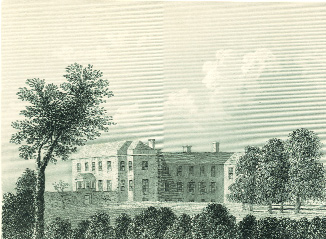
Engraving of Delville by Letitia Bushe.
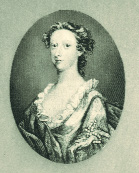
Oval miniature of the young Mrs Delany.
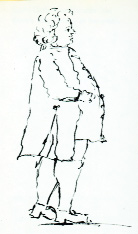
Mrs Delany’s drawing of her husband, Dean Patrick Delany.
Her first port of call was to her ‘English room’. This was her own apartment in Delville, decorated to her taste. Mrs Delany would set to there and plan the day. First, the bill of fare or menu for dinner had to be decided upon. Salting, smoking or pickling were the only methods of food preservation available in pre-refrigeration times so food was seasonal. There might be pies or pasties left over from previous days. These so-called ‘made dishes’ were useful larder standbys and would fill a gap if available, but most of the food was cooked from scratch daily. The size and scope of the dinner greatly depended on how many visitors were expected and, more importantly, on their status. The Delanys enjoyed their food and their table was a hospitable one so they rarely dined alone. Dinner was eaten between two and three o’clock in the afternoon; there was no time to waste. Mrs Delany, in consultation with the housekeeper and cook, drew up the bill of fare.
Mrs Delany often complained to her sister Anne about her servants or ‘domestics’, as she called them. She once wrote about being put into a sad fuss by a housekeeper whom she described as short and fat-necked. This unfortunate woman complained one day of a violent headache, which obliged Mrs Delany to call on their neighbour, Dr Barber, to attend her. Typical of the medications of the day, she was given an emetic purge to make her vomit up excess bile and was bled, a fail-safe to galvanise her back into action. Mrs Delany wrote, somewhat balefully, that had the housekeeper perished she would have proved a sad loss because she was an otherwise excellent and trustworthy servant.
Trustworthiness in a housekeeper was important. She had to provision the kitchen stores. To do this she was given an imprest account, which was money advanced to her from Mrs Delany herself, every penny of which had to be accounted for. It was also her job, according to The Modern Cook or Housewife’s Directory, printed in Dublin in 1766, ‘to ensure there were stocks of nutmegs, cinnamon, ginger, cloves, mace, Jamaica pepper, long pepper, black pepper, red sage, sage of virtue, mint, thyme, penny-royal, sweet marjoram, kept dry in paper bags if not already in the garden or in season’. She had ‘to know whether what is bought, be new or stale, young or old’. According to The Modern Cook:
‘A woodcock if fat will feel thick and hard in the vent, and have a fat vein upon the side of the breast under the wing; but if lean it will feel thin in the vent; if new killed limber-footed; if stale, dry-footed. Have a care that it hath not got a snotty nose, or a moorish muddy throat; you may know that by squeezing the throat.’
Breakfast
When the dinner menu was settled and the housekeeper and cook dispatched to their duties, it was time for breakfast. An eighteenth-century breakfast was not a substantial meal; it was a stopgap and was usually taken in Delville between nine and ten o’clock in the morning.
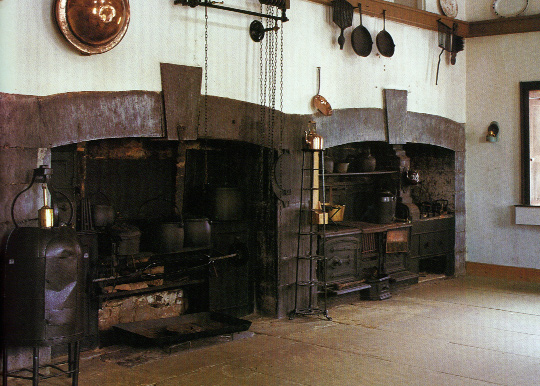
The kitchen at Strokestown Park House, similar to Mrs Delany’s at Delville. (Barbara and René Stoeltie)
Bread and butter were breakfast staples, taken with beverages of tea, coffee or chocolate. These by now commonplace drinks were unimaginable luxuries to any but the very wealthy in Georgian Ireland. Household accounts for the Vigors family, substantial landowners in Burgage, Co. Carlow, show that Bohea tea, a black tea from China favoured by Mrs Delany, cost three shillings and threepence for half a pound in 1758. A conversion to contemporary values translates that as roughly E28 for half a pound of tea; this fantastic price explains why tea was locked away in special caddies and why the mistress held the key.
Dinner
By two o’clock the household was ready for dinner. Mrs Delany had described her bill of fare in a letter to her sister Anne in England:
‘How I could run on, but must not. I am called to range dishes on my table, which is a long one, and consequently easier to set out than a round or oval one. The table takes seven dishes in length. Here follows my bill of fare for today. First course—Turkeys endove [endive], boyled [boiled] neck of mutton, greens, soup, plum-pudding, roast loin of veal, venison pasty. Second course—partridge, sweetbreads, collared pig, creamed apple tart, crabs, fricassee of eggs, pigeons.’
Mrs Delany rounded off this letter by saying ‘no dessert to be had’.
It was customary in the middle of the eighteenth century to divide dinner into two courses of mixed sweet and savoury dishes, followed by a dessert course. There were two ‘covers’ of many dishes, arranged usually in geometric patterns and all set out on the table at one time. Mrs Delany’s long table could accommodate the seven key dishes of each course laid lengthways. A variety of dishes, a good balance of flavours and symmetry in the table setting were important principles of eighteenth-century dining. The intention was to feast the eye, to provide a free-ranging tasting menu and to reinforce that eighteenth-century social imperative—impress the guests.
On this day at Delville, with fourteen dishes over two courses, the physical work for the kitchen staff was prodigious, and the chief burden fell on the cook. Mrs Delany was far from encouraging when she wrote to Anne prior to one of her visits home to England: ‘I have got now but a very indifferent cook, not worth transporting’ (23 January 1753). Woe betide the cook who incinerated an expensive joint of beef on one side or produced it raw on the other. Cooking was done on or before the open hearth, using pulleys and cranes for suspending pots over the heat of the fire.

A typical eighteenth-century dining room at Newbridge House, Co. Dublin. (Cobbe Family Trust and Fingal County Council)
There was no knob to turn the fire up or down, on or off, so any cook worth her salt had to be capable of judging the temperature to a nicety. Hannah Glasse, in The Art of Cookery (1762), desired the cook ‘to order her fire according to what she is to dress [cook]; if anything very little or thin [the partridge or pigeon on Mrs Delany’s menu, for example], then a pretty little brisk fire, that it may be done quick and nice. If a very large joint, then be sure a good fire laid to cake [consistently hot to bake a cake evenly].’
Challenge of keeping food warm
Meat was roasted on spits, laboriously turned by hand, and Mrs Delany was always innovative, if not always sympathetic. In another London house, to lighten the load of her kitchen domestics, whom she called ‘Cinderellas’, she introduced a smoke-jack spit. The smoke from the fire agitated blades set into the chimney, which rotated the spit and thereby reduced Cinderella’s drudgery. Meanwhile in Delville cook was fussing about her sauces and gravies. She was hot and bothered and ready to dish up but she had the problem of keeping the food warm. This was a daily challenge because it had to travel quite a distance from the kitchen through freezing passageways to reach the dining room. She had her sauces in pans standing on trivets around the grate. Bains-marie or double boilers kept other dishes warm, while chafing dishes, which had little chambers of hot charcoals underneath, were used for the remainder.
The heat and sweat of the kitchen were not mirrored in the dining room. The opposite prevailed: this was an oasis of calm, refined—not to say chilly—living. Cookery writers of the day helpfully suggested removing the cold fat that swims upon the gravy in cold weather—a useful tip, as Mrs Delany had often remarked freezing temperatures at Delville. She described her dining room (or eating parlour, as she called it) in a letter to Anne:
‘On the right hand [of the hall] is the eating parlour, 26 f. long and 16 f. and a half wide, with a projection in the middle, which opens thirteen foot and is eight foot deep, with three windows, and large enough for two side-boards.’
On formal occasions, the best pieces of family silver or plate were set up on the sideboard to dazzle the guests as they crossed the threshold. No opportunity was neglected to demonstrate wealth and status.
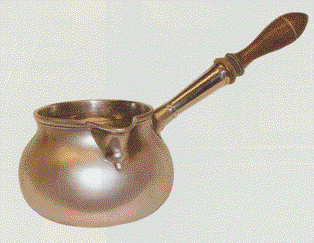
Early Georgian saucepan. (Irish Antique Dealers’ Association)
Footmen in livery
Footmen came in for regular mention in Mrs Delany’s letters. The eating parlour was their arena. They were generally fine, vain young fellows in livery, given full reign to prance and preen through the dinner service. Mrs Delany charitably named one of them Fatty John. The butler oversaw all operations. As the average eating parlour had no cupboard space at that time, the footmen paraded in with the napery, leathers, baize cloths, linen damask tablecloths and napkins, plates and glasses. The cutlery was safely locked in knife boxes and was the responsibility of the butler. Under his careful eye, the footmen laid out the table according to the mistress’s bill of fare or blueprint. Other dining room accoutrements such as plate-carriers or buckets, plate-warmers, dumb-waiters, wine-coolers, cheese-coasters, bottle-sliders and cellarets were introduced as indispensable appointments as the century wore on.
When the company at Delville had partaken of their first course of turkey, mutton, greens, soup, plum pudding, veal and venison pasty, the dishes were removed by the footmen. This removal caused a hiatus between courses but the company could chit-chat delightfully in the interval. The second, lighter course of partridge, sweetbreads, collared pig (boned, stuffed, rolled and kept fresh in a pickling liquid), apple tart, crabs, fricassee of eggs (eggs in a white sauce) and pigeon was then placed on the table. Little side dishes of biscuits and pickles also often stayed on the table throughout the meal. Dinner guests were not obliged to devour everything in sight but to partake of a little from each dish. There was no shortage of wine. The butler had responsibility for the master’s cellar. Wineglasses were not set on the table before the meal but were brought to each diner on a salver. When the glass was drained, it was returned to the sideboard, rinsed with water and refilled.
In the earlier part of the century the mistress of the house was obliged to carve the meat for the whole company, but this practice had waned and by the middle of the century Mrs Delany could eat her dinner in peace and still fulfil her duties. According to eighteenth-century rules of hospitality, she had to ensure that her company was well fed and brought into conversation according to rank, gender and age. Rank, of course, came first. Men and women were seated alternately male and female around the table; the diners helped themselves to dishes within reach or asked for others to be passed round, which greatly added to the general conviviality. Dinner might take two or three good hours in the middle of the day, but Mrs Delany, who greatly resented her time being wasted, never complained about that.
‘Gentleman’s comforter’
After dinner the women withdrew from the eating parlour while the men quaffed on and talked importantly. This exodus had another purpose. Situated usually in a corner or near the door was a discreet little cabinet called a ‘gentleman’s comforter’ or ‘necessary’. It contained a chamber-pot.
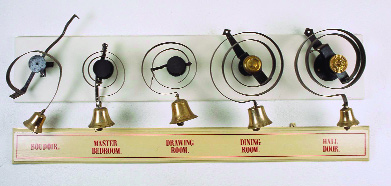
The servants’ bells at 29 Lower Fitzwilliam Street-‘elegant refinement above the waterline, sustained by furious paddling below’. (ESB)
The gentlemen relieved themselves into this vessel to the great satisfaction of all parties, with the possible exception of Fatty John, who had the job of emptying it. If the call of nature proved pressing for the ladies, they could use vessels known as voideurs. These receptacles were shaped like sauceboats and required a certain adroitness, but then life was never easy for women. When all the company was fed, watered and comfortable, they regrouped, took tea in the drawing room, chit-chatted some more and then dispersed to spend the rest of the day as they wished. Supper was a few hours away yet and Mrs Delany had lots to do in the meantime. Her husband, Dean Patrick Delany, had once written: ‘She hath works for all hours and occasions and finds full employment for her hands even between the coolings of her cups of tea’.
Supper
Suppers were commonly leftovers from dinner, served cold. This allowed the kitchen fires time to settle down and the kitchen domestics their rest. Supper was a lighter meal than dinner, though some eighteenth-century physicians denounced it as a pernicious custom, sure to overload the digestive system. The Modern Cook suggested ‘ready messes for suppers’, most of which were the so-called ‘made’ or pre-prepared dishes. The list includes:
‘. . . brawn [jellied calf’s head], ham, Dutch or hung beef [dried beef, served grated or cut into slivers], collard beef [boned, stuffed, rolled and pickled], mutton, pig, veal, pork, potted beef [preserved in sugar, saltpetre and spices, with a liquor of gravy and butter poured over to seal the pots], pigeons, hare, venison, eel, char [a fish of the salmon family], lampreys [an eel-like fish considered a delicacy and often potted], trouts, etc.’
Mrs Delany—who, not surprisingly, once described herself as ‘a porpoise grown’—gives us an example of just such a supper, enjoyed in Dublin in 1733:
‘Yesterday we spent at home, had a petite assembly, which we among ourselves call a “ridotto”, because at ten o’clock we have a very pretty tray brought in, with chocolate, mulled wine, cakes, sweetmeats [preserved and candied fruits, seeds, etc.] and comfits [fruits, nuts or seeds coated in boiled sugar, not unlike sugared almonds]; cold partridge, chicken, lamb, ham, tongue, — all set out prettily and ready to pick at [24 January 1733].’
After supper, taken usually around ten o’clock at Delville, the family might read or talk around the dying fire until it was time for bed. The dean would take his candle and his caudle upstairs. Caudle was gruel with wine, eggs, sugar and spices added. It would send him nicely off to dreamland. Mrs Delany’s maid would unwind her stays and help her out of her garments—a blessed relief, because indigestion had once prompted her to write: ‘I eat half a roasted onion for my supper, and I dreamt of hobgoblins!’ (February 1786).
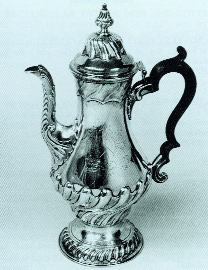
Eighteenth-century coffee pot. (Hamilton Osborne King)Eighteenth-century coffee pot. (Hamilton Osborne King)Eighteenth-century coffee pot. (Hamilton Osborne King)
The domestics in Delville were well fed too on a reduced version of the family diet, one of the perks of the job. They were mostly asleep by now on their pallets in the kitchen or in their freezing garrets, too tired to dream. Morning light wasn’t far off and the whey was standing by in the crock in the cool larder, waiting to start another day.
Katherine Cahill is a senior researcher in RTÉ.
Further reading:
K. Cahill, Mrs Delany’s menus, medicines and manners (Dublin, 2005).
Rt Hon. Lady Llanover (ed.), The autobiography and correspondence of Mary Granville, Mrs. Delany: with interesting reminiscences of King George the Third and Queen Charlotte (London, 1st series, 3 vols, 1861; 2nd series, 3 vols, 1862).
P. McCarthy, ‘Vails and travails: how Lord Kildare kept his household in order’, Journal of the Irish Georgian Society VI (2003).
















